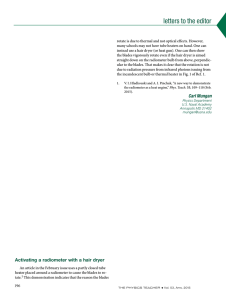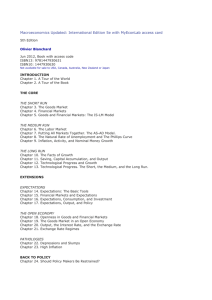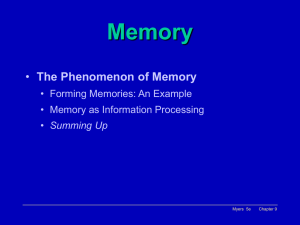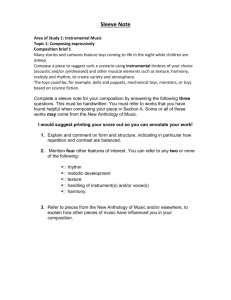Station Break Students conduct simple investigations to identify different ways that energy
advertisement
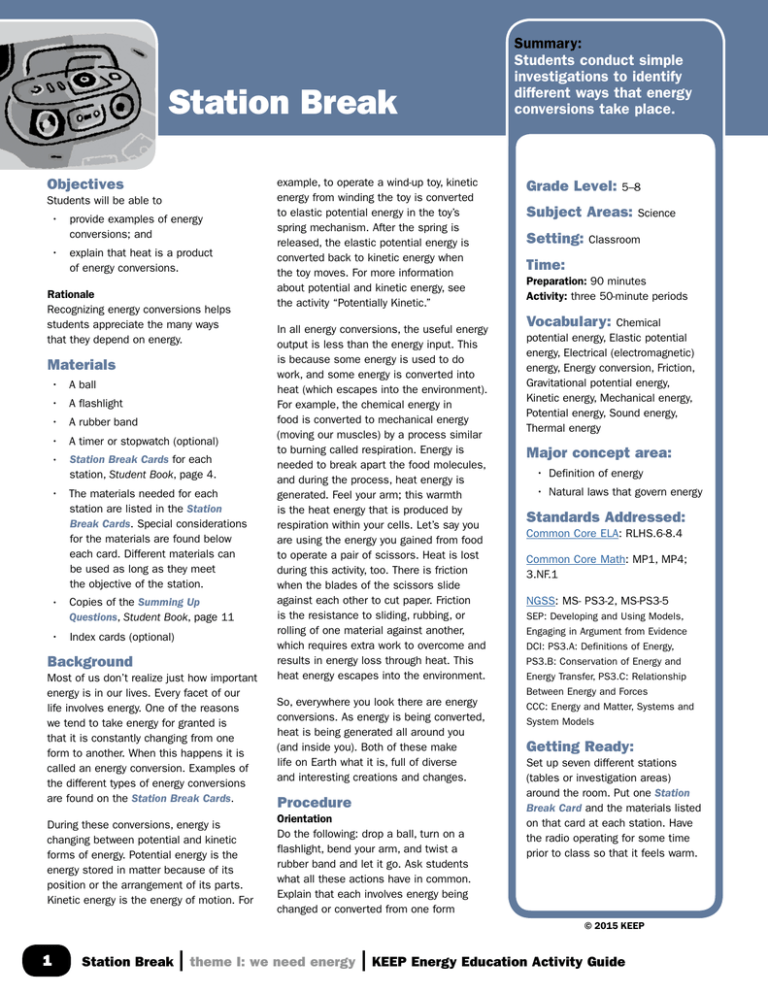
Station Break Objectives Students will be able to • provide examples of energy conversions; and • explain that heat is a product of energy conversions. Rationale Recognizing energy conversions helps students appreciate the many ways that they depend on energy. Materials • A ball • A flashlight • A rubber band • A timer or stopwatch (optional) • Station Break Cards for each station, Student Book, page 4. • The materials needed for each station are listed in the Station Break Cards. Special considerations for the materials are found below each card. Different materials can be used as long as they meet the objective of the station. • Copies of the Summing Up Questions, Student Book, page 11 • Index cards (optional) Background example, to operate a wind-up toy, kinetic energy from winding the toy is converted to elastic potential energy in the toy’s spring mechanism. After the spring is released, the elastic potential energy is converted back to kinetic energy when the toy moves. For more information about potential and kinetic energy, see the activity “Potentially Kinetic.” In all energy conversions, the useful energy output is less than the energy input. This is because some energy is used to do work, and some energy is converted into heat (which escapes into the environment). For example, the chemical energy in food is converted to mechanical energy (moving our muscles) by a process similar to burning called respiration. Energy is needed to break apart the food molecules, and during the process, heat energy is generated. Feel your arm; this warmth is the heat energy that is produced by respiration within your cells. Let’s say you are using the energy you gained from food to operate a pair of scissors. Heat is lost during this activity, too. There is friction when the blades of the scissors slide against each other to cut paper. Friction is the resistance to sliding, rubbing, or rolling of one material against another, which requires extra work to overcome and results in energy loss through heat. This heat energy escapes into the environment. Most of us don’t realize just how important energy is in our lives. Every facet of our life involves energy. One of the reasons we tend to take energy for granted is that it is constantly changing from one form to another. When this happens it is called an energy conversion. Examples of the different types of energy conversions are found on the Station Break Cards. So, everywhere you look there are energy conversions. As energy is being converted, heat is being generated all around you (and inside you). Both of these make life on Earth what it is, full of diverse and interesting creations and changes. During these conversions, energy is changing between potential and kinetic forms of energy. Potential energy is the energy stored in matter because of its position or the arrangement of its parts. Kinetic energy is the energy of motion. For Orientation Do the following: drop a ball, turn on a flashlight, bend your arm, and twist a rubber band and let it go. Ask students what all these actions have in common. Explain that each involves energy being changed or converted from one form Procedure Summary: Students conduct simple investigations to identify different ways that energy conversions take place. Grade Level: 5–8 Subject Areas: Setting: Science Classroom Time: Preparation: 90 minutes Activity: three 50-minute periods Vocabulary: Chemical potential energy, Elastic potential energy, Electrical (electromagnetic) energy, Energy conversion, Friction, Gravitational potential energy, Kinetic energy, Mechanical energy, Potential energy, Sound energy, Thermal energy Major concept area: • Definition of energy • Natural laws that govern energy Standards Addressed: Common Core ELA: RLHS.6-8.4 Common Core Math: MP1, MP4; 3.NF.1 NGSS: MS- PS3-2, MS-PS3-5 SEP: Developing and Using Models, Engaging in Argument from Evidence DCI: PS3.A: Definitions of Energy, PS3.B: Conservation of Energy and Energy Transfer, PS3.C: Relationship Between Energy and Forces CCC: Energy and Matter, Systems and System Models Getting Ready: Set up seven different stations (tables or investigation areas) around the room. Put one Station Break Card and the materials listed on that card at each station. Have the radio operating for some time prior to class so that it feels warm. © 2015 KEEP 1 Station Break l theme I: we need energy l KEEP Energy Education Activity Guide Resources: For a list of additional resources related to this activity, visit the KEEP website at keepprogram.org and click on Curriculum & Resources to another. Review the definition and forms of energy. Forms of energy used in this activity include the following: • Chemical energy • Elastic energy • Electrical (electromagnetic) energy • Light energy • Heat energy • Mechanical energy (motion) • Sound energy Steps NOTE: This activity orients students to a variety of energy conversions by having groups rotate around the room to portray each type of conversion. An alternative is to demonstrate one energy conversion at a time, allowing time for groups to conduct investigations and further explore that conversion before moving on to the next demonstration. See Related KEEP Activities for additional investigation ideas. 1.Tell students they will be gaining experience with energy conversions. Show them the stations set up around the classroom. Inform them that their job is to visit each station for five minutes. At each station they should: • read the written directions for the investigation found on the card at that station; • perform the investigation as directed; • read and discuss the Summing Up Questions and record their answers (try to make a group decision in answering questions 2. Divide students into groups of three or four and provide each group with the Summing Up Questions. Each group member can have a specific task or role at the stations. For example, one student is the Reader and Director, leading discussions and making sure the others know what to do. Another student can be responsible for conducting the experiment. Another student, the Recorder, records responses to the KEEP Energy Education Activity Guide Summing Up Questions. Students may want to alternate roles with each station. 3.Assign each group to a station and have them begin, moving to the next station after five minutes. 4. After students have been to all the stations and completed the Summing Up Questions, hold a class discussion. Students will likely give a wide variety of answers. 5.Go through each station and discuss the energy conversions that took place for each device. Get the class to reach a consensus on the conversions. Using an overhead transparency, diagram the changes involved (see information associated with the Station Break Cards). Unless mentioned by students, do not identify heat in the conversions yet. 6.Ask students if there were any stations in which more than one energy conversion took place. Any station in which batteries were used had more than one energy conversion involved. The batteries converted chemical energy to electrical energy. This electrical energy was then used to produce sound or motion, and heat. 7. Ask students if anyone noticed any other forms of energy being converted at the stations. Instruct one of the students to feel the radio that has been operating for some time. They should notice that the radio is warm. The warmth illustrates that heat energy was also formed in this conversion. 8.Challenge students to comment on other instances where they observed heat being given off. Point out that during any transformation of energy from one form to another, heat is also given off; however, it is less apparent in some conversions than others. Revise the energy diagrams to reflect the formation of heat in the conversion. l theme I: we need energy l Station Break 2 Summary: Students use research skills to investigate various viewpoints surrounding Closure Have students define the term “energy conversion.” Challenge students to do the following: • Locate at least five devices or objects around the school or at home that convert energy • List the forms of energy needed to operate each item • Identify the form or forms of energy into which it is converted • Note the type of device or object involved Assessment Formative • Did students follow the directions at each station? • How accurately did they respond to the Summing Up Questions? • Are they able to identify other energy conversions in their lives? 3 Station Break Summative Have students work in small groups or individually. Instruct each group to write down the different forms of energy used during this activity on index cards or pieces of paper (one form per card). Have students randomly select two cards at a time and lay them on the table. Their task is to try to identify a conversion process that can change energy from the form stated on one card to the one listed on the second. For example, if the two cards they draw are electricity and sound, their answer could be when you turn on the radio (electricity) you can hear it (sound). Assign each student to select five combinations of cards and record their responses. For more of a challenge, students can draw three cards each time. Related KEEP Activities: Prior to this activity, students should be able to identify the different forms of energy. See activities such as “Evidence of Energy” and “Potentially Kinetic.” To have students further investigate the forms of energy, see the activity “Exploring Heat” and K–5 Energy Sparks for Theme I: “Exploring Sound, Exploring Light Energy,” and “Exploring Movement.” More advanced students may be interested in participating in “People Power” and doing calculations described in Energy and Power Conversion Factors in the Appendix. Credits: Activity adapted from University of Northern Iowa Center for Energy and Environmental Education, Energy Education Curriculum Project. “Station Break” pp. 7–17, and 78–86 in Energy Education Curriculum Project: Energy Conversions: Middle School Module 2. Cedar Falls, Iowa: University of Northern Iowa and Iowa Energy Center, 1995. Used with permission. All rights reserved. l theme I: we need energy l KEEP Energy Education Activity Guide Station Break Cards Station 1: The Radiometer Materials Radiometer, hair dryer, flashlight or lamp, paper fan Let’s Investigate Use each of the materials available at this station one at a time to rotate the blades of the radiometer. Summing Up 1. Describe what you did and what results you observed in testing the radiometer. Be sure to discuss methods that did not work, as well as those that were successful. 2. What form of energy was needed to make the radiometer spin? 3. Into what form of energy was this converted? Instructions: Cut out Station Break Cards 1-7 and place at stations. Special Consideration for Materials at The Radiometer Station A radiometer is a light bulb-shaped device that contains an object that looks like a weather vane (wings arranged in a circle like spokes of a wheel that can move). Sample Answers for The Radiometer Summing Up 1. Light from the flashlight does the best job of rotating the radiometer wings. Heat from the hair dryer causes the wings to rotate for a few seconds. Fanning has no effect on the radiometer wings. 2. Light energy was needed to rotate the radiometer. 3. Light energy was converted to mechanical energy as the wings moved. Additional Information: The original radiometer was invented by Sir William Crookes in the mid-nineteenth century. The device was developed to measure the intensity of radiant energy or heat. What makes the radiometer work? The atmosphere inside a radiometer is a nearly perfect vacuum. More than 99 percent of the air has been removed, leaving only thousands of air molecules inside the radiometer in comparison with the trillions in the atmosphere outside it. This means that each molecule of air inside the radiometer is able to move about more freely. The opposing sides of each vane or wing of the radiometer are alternately dark and light in color. When light energy—infrared radiation—strikes these wings, it transfers heat to each one, but not to the same degree. The lighter side of the wing reflects light, and the dark carbonized side absorbs light. When the freely moving air molecules inside the radiometer strike the light colored side of the wing, they take on very little energy and do not bounce off very fast. However, when the molecules strike the dark side, they take on a great deal of energy and “kick” away at terrific speed. This causes the vane to spin in the direction it has been kicked (away from the dark carbonized side of the wing). In other words, the temperature difference between the two sides causes the vane to move due to convection currents and momentum transfer. Conversion Diagram Light Energy Mechanical Energy + Heat Energy Radiometer l l KEEP Energy Education Activity Guide - Student Book theme I: we need energy Station Break Cards 4 Station 2: Quiet, Please! Materials Battery-operated portable radio, battery-operated portable tape recorder, battery-operated toys Let’s Investigate 1. Experiment with each object at this station. 2. Determine which form of energy is needed to get each object to work. 3. Observe each object in action; then determine which form of energy the working object has. Summing Up 1. What form of energy was needed to make each object work? 2. Into what form or forms of energy was this converted in each object? Sample Answers for Quiet, Please! Summing Up 1. Each object tested is powered with batteries. Batteries convert chemical energy into electrical form. See Anatomy of a Battery in “Circuit Circus” in the Energy Education Activity Guide to help understand how batteries make this conversion. 2. Mechanical and sound energy were produced in all of the devices. All of the devices produced heat as well (although the heat may not have been felt or detected). Conversion Diagrams Toys Chemical Energy Electrical Energy Mechanical Energy + Heat Electrical Energy Sound Energy + Heat Battery Radio Chemical Energy Battery 5 l l Station Break Cards theme I: we need energy KEEP Energy Education Activity Guide - Student Book Station 3: Stretching it Materials Rubber bands of various thicknesses Let’s Investigate 1. Experiment with each of the different rubber bands at this station. 2. Stretch each of them back and forth quickly. 3. After several pulls, test the temperature of each rubber band by touching them, individually, to your upper lip. 4. Test to see which thickness of rubber band gets the warmest. Summing Up 1. What form of energy was needed to stretch the rubber bands? 2. What form of energy caused the rubber bands to return to their original shapes? 3. What other form of energy was involved in this experiment? Sample Answers for Stretching It Summing Up 1. Mechanical energy was needed to stretch each of the rubber bands. 2. Elastic potential energy caused the rubber bands to return to their original shape. 3. Heat energy was produced by the rubber bands as they were stretched and unstretched. Conversion Diagram Mechanical Energy Person (stretching rubber band) Elastic Potential Energy l Mechanical Energy + Heat l KEEP Energy Education Activity Guide - Student Book theme I: we need energy Station Break Cards 6 Station 4: Toyland Materials Wind-up toys that move forward, jump, or spin Let’s Investigate 1. Experiment with each of the toys. 2. Determine which form of energy is needed to get each of the toys to work. 3. Observe each toy in action, then determine which form of energy the working toy is displaying. Summing Up 1. What form of energy was needed to make each toy work? 2. What form or forms of energy were displayed by the working toys? Sample Answers for Toyland Summing Up 1. Each toy had to be wound up to move. This means that mechanical energy was added to each toy, since your hand wound each toy. 2. Each of the working toys has mechanical energy, shown by their motion. Sound and heat were also given off by the toys, but the heat may not have been noticeable. Conversion Diagram Mechanical Energy 7 Person (winding up toy) l Elastic Potential Energy + Heat l Toy (unwinding) Mechanical Energy + Sound Energy +Heat Station Break Cards theme I: we need energy KEEP Energy Education Activity Guide - Student Book Station 5: Bring in Da Noise! Materials Party noisemaker, bell,wind or percussion instruments (e.g., tambourines, triangles, kazoos) Let’s Investigate 1. Experiment with each object. 2. Determine which form of energy is needed to get each object to work. 3. Observe each object in action, then determine which form of energy the working object is displaying. Summing Up 1. What form of energy was needed to make each object work? 2. Into what form or forms of energy was this converted in each of the working objects? Special consideration for Materials at the Bring in Da Noise! Station If you use a wind instrument such as a kazoo, you may want to have one clean kazoo for each group. Sample Answers for Bring in Da Noise! Summing Up 1. Each instrument worked by either blowing on it or by hitting it. Both of these actions involve mechanical energy. 2. Each of the working objects produced sound energy. Conversion Diagram Mechanical Energy Instrument Sound Energy Heat Energy l l KEEP Energy Education Activity Guide - Student Book theme I: we need energy Station Break Cards 8 Station 6: PB & J Materials Peanut butter, jelly, bread, plastic knives, warm soapy water, sponge or washcloth Let’s Investigate 1. Make sure the station is clean. 2. Use a clean knife to make a peanut butter and jelly sandwich. 3. Divide it into thirds or quarters. 4. Your teacher will tell you whether to eat the sandwiches. 5. Clean up the station when finished. Summing Up 1. What form or forms of energy were needed to produce each of the items in the sandwich? 2. What form of energy is present in the sandwich now? 3. Into what form or forms of energy does the sandwich change after it’s eaten? Special Consideration for Materials at the PB & J Station If there are nut allergies, avoid using any nut butters (alternatives to peanut butter include sunflower seed butter and soybean butter). If sanitation is a concern, do not allow students to eat the sandwiches. Sample Answers to PB & J Summing Up 1. Students should know that these products require the sun’s energy, or light, to grow. If processed foods are used, students may list some of the forms of energy required during the processing phase, such as chemical energy in fossil fuels and electricity. 2. Food stores energy in the form of chemical energy. 3. Once eaten, the chemical energy stored in the sandwich is converted into heat and mechanical energy (muscle movement). Many students will not realize that heat energy is formed also. Conversion Diagram Chemical Energy 9 Food (respiration) l Mechanical Energy l Heat Energy Station Break Cards theme I: we need energy KEEP Energy Education Activity Guide - Student Book Station 7: Plug It In! Materials Hair dryer, fan, electric pencil sharpener Let’s Investigate 1. Experiment with each object. 2. Determine which form of energy is needed to get each object to work. 3. Observe each object in action, then discuss with your partners which form of energy the working object is displaying. Summing Up 1. What form of energy was needed to make each object work? 2. Into what form or forms of energy was this converted in each working object? Special Consideration for Materials at the Plug It In! Station Materials could include any devices that need to be plugged in to operate. This station must be located near an electrical outlet. Each device should produce motion and/or heat. Sample Answers to Plug It In! Station Summing Up 1. Each device needs electrical energy to make it operate. 2. Each of the working devices produces mechanical energy or sound energy or both, and heat. Conversion Diagram Electrical Energy Electrical Energy Hair Dryer Toaster Mechanical Energy Heat Energy Heat Energy l l KEEP Energy Education Activity Guide - Student Book theme I: we need energy Station Break Cards 10 Summing Up Questions Station 1: The Radiometer Summing Up Questions 1. Describe what you did and what results were observed in testing the radiometer. Be sure to discuss methods that did not work as well as those that were successful. 2. What form of energy was needed to make the radiometer spin? 3. Into what form of energy was this converted? Station 2: Quiet, Please! Summing Up Questions 1. What form of energy was needed to make each object work? 2. Into what form or forms of energy was this converted in each object? Summing Up Questions Station 3: Stretching It 1. What form of energy was needed to stretch the rubber bands? 2. What form of energy caused the rubber bands to return to their original shapes? 3. What other form of energy was involved in this experiment? Station 4: Toyland Summing Up Questions 1. What form of energy was needed to make each toy work? 2. What form or forms of energy were displayed by the working toys? 11 l l Station Break Cards theme I: we need energy KEEP Energy Education Activity Guide - Student Book Station 5: Bring in Da Noise! Summing Up Questions 1. What form of energy was needed to make each object work? 2. Into what form or forms of energy was this converted in each working object? Summing Up Questions Station 6: PB & J 1. What form or forms of energy were needed to produce each of the items in the sandwich? 2. What form of energy is present in the sandwich now? 3. Into what form or forms of energy does the sandwich change after it’s eaten? Station 7: Plug It In! Summing Up Questions 1. What form of energy was needed to make each object work? 2. Into what form or forms of energy was this converted in each working object? l l KEEP Energy Education Activity Guide - Student Book theme I: we need energy Station Break Cards 12
